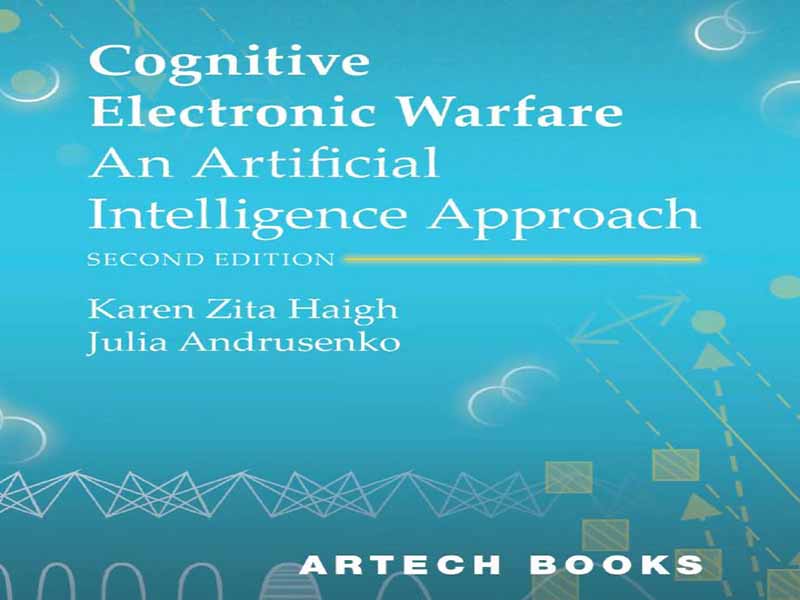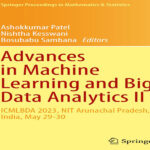- عنوان کتاب: Cognitive Electronic Warfare
- نویسنده: Karen Zita Haigh, Julia Andrusenko
- حوزه: جنگ الکترونیک
- سال انتشار: 2025
- تعداد صفحه: 432
- زبان اصلی: انگلیسی
- نوع فایل: pdf
- حجم فایل: 5.91 مگابایت
جنگ الکترونیک شناختی (CogEW) در چهار سال گذشته، با پیشرفتهایی در هوش مصنوعی (AI)، یادگیری ماشین (ML) و رادیوهای تعریفشده توسط نرمافزار، دستخوش تحول چشمگیری شده است. جنگ الکترونیک مدرن که زمانی متکی بر سیستمهای ایستا و مبتنی بر قانون بود، اکنون فناوریهای تطبیقی و خودمختاری را در بر میگیرد که قادر به حس کردن، یادگیری و پاسخ پویا به محیطهای الکترومغناطیسی پیچیده هستند. پیشرفتها در یادگیری تقویتی عمیق، اکنون سیستمها را قادر میسازد تا استراتژیهای پارازیت و رهگیری را در زمان واقعی و سریع بهینه کنند. آگاهی از وضعیت طیف و طبقهبندی سیگنال، آگاهی از وضعیت را افزایش میدهد، در حالی که محاسبات لبه، تصمیمگیری غیرمتمرکز را تسریع میکند. تکنیکهایی مانند یادگیری انتقالی، سازگاری سریع با انواع سیگنالهای جدید با دادههای محدود را امکانپذیر میکند، در حالی که روشهای نوظهوری مانند یادگیری صفر-شات، پتانسیل شناسایی سیگنالهای قبلاً دیده نشده را بر اساس ویژگیهای سیگنال سطح بالا نشان میدهند. در عین حال، یادگیری ماشینی خصمانه، هم آسیبپذیریهای جدید و هم روشهای نوآورانهای را برای مقابله با تهدیدات مبتنی بر هوش مصنوعی معرفی میکند. این نسخه، تغییرات فناوری را که از آخرین نسخه در سال 2021 رخ داده است، به تصویر میکشد. بیشتر این تغییرات در هوش مصنوعی است که در موجی از تغییرات در حال گسترش است. چند پیشرفت در جنگ الکترونیک یا سختافزار وجود دارد. این کتاب از ۲۴۶ صفحه به ۴۰۷ صفحه افزایش یافت، با مطالب جدید فراوان و بازسازی مطالب قبلی. تغییرات عمده عبارتند از: • در چاپ اول، انتظار داشتیم که بیشتر خوانندگان ما متخصص فرکانس رادیویی (RF) باشند و نیازی به توضیح مفاهیم طیف الکترومغناطیسی (EMS) یا نحوه عملکرد رادیو یا رادارها نداشتیم. از متخصصان هوش مصنوعی آموختیم که این اولین باری است که کسی مسئله RF را با کلماتی که برای آنها قابل درک بود، توضیح داده است. به همین دلیل، بحث بیشتری در مورد EMS، از جمله مکالمهای در مورد جنگ الکترونیک غیرنظامی، اضافه کردیم. نگاشت بین رادیو شناختی، رادار شناختی و جنگ الکترونیک شناختی اکنون برجستهتر شده است. • ما گفتگو در مورد برخی از ابزارهای مدرن هوش مصنوعی، از جمله شبکههای عصبی اسپایک، مدلهای زبان بزرگ، هوش مصنوعی مولد و یادگیری تقویتی عمیق را اضافه کردیم. همچنین بحثی در مورد نحوه ساخت مدلهایی که در لبه، با محاسبات، قدرت و ارتباطات محدود کار میکنند، اضافه کردیم. اکنون گفتگوهای صریحتری در مورد هک پاداش وجود دارد. • ما فصل «آزمون و ارزیابی» را به طور قابل توجهی بازنویسی کردیم تا چالشهای سیستمهای آزمایشی که پس از استقرار یاد میگیرند را بهتر به تصویر بکشیم. آزمایش سیستمهای مبتنی بر هوش مصنوعی در حال حاضر موضوعی پرطرفدار است؛ ما گام دیگری در بحث تفاوت بین هوش مصنوعی و شناختی و معنای آن برای تضمین سیستمهای شناختی برداشتهایم. • ما پروژههای متنوعی را با هدف ایجاد مثالهای عملی و مختصر برای شروع کار شما اضافه کردهایم. هر ایده میتواند به سیستمهای بزرگتر و قابل استقرار تبدیل شود. در همین راستا، ما مثالهای بیشتری از چگونگی ظهور مفاهیم شناختی در یک سیستم RF، از جمله توسعه سیستمها و گفتگوی طولانیتر در مورد ارزیابی آسیب نبرد EW (EW BDA) اضافه کردهایم. • ما بحثی در مورد برخی از سختافزارهای جدیدتر، از جمله نورومورفیک، فوتونیک و کوانتومی، اضافه کردهایم. متاسطحها – فناوری پشت شنلهای نامرئی – در حال حاضر یک واقعیت هستند و نقش مهمی در 6G ایفا میکنند. در EW، آنها نوآوریهایی را در حسگری، پنهانکاری، ارتباطات و رادار ایجاد میکنند. متامواد شاید قویترین عامل انگیزشی برای بهینهسازی و یادگیری سریع در زمان واقعی در EW باشند. • ما بحث خود را در مورد مدیریت دادهها، از جمله معناشناسی، فراداده و طرحوارهها، گسترش دادیم. ما همچنین لیست مجموعه دادههای RF را افزایش دادیم. اگرچه تعداد مجموعه دادههای عمومی RF هنوز کم است، اما دیگر به طرز شرمآوری کوتاه نیست. • ما یک بخش کامل در مورد سرعت هوش مصنوعی اضافه کردیم و سعی کردیم نرخ تغییر را توصیف کنیم. شاید قویترین شاخص سرعت تغییر این باشد که بهروزرسانیهای روزانه وجود داشت. DeepSeek، مدلی که در اواسط ژانویه ۲۰۲۵ جهان را تکان داد، در کمتر از دو هفته توسط دو مدل دیگر از میدان به در شد. مثل ریگ روان به نظر میرسید: تا زمانی که یک جمله را کامل میکردیم، دیگر قدیمی شده بود. تقریباً ۴۰٪ از استنادات این نسخه به آثاری است که در سال ۲۰۲۱ یا بعد از آن منتشر شدهاند و ما به سختی به سطح آنچه در دسترس است، پرداختیم. درسی که برای خوانندگان آموخته شد این است که هر استناد یا توصیهای مبنی بر اینکه یک تکنیک به خوبی کار میکند، باید با کمی تردید پذیرفته شود: احتمال بسیار زیادی وجود دارد که چیزی بهتر از آن بیرون آمده باشد. امیدواریم که به اندازه کافی ایدهها و کلمات کلیدی در اختیار شما قرار داده باشیم تا بتوانید خلاقانه فکر کنید و به طور مؤثر جستجو کنید.
Cognitive electronic warfare (CogEW) has undergone a remarkable transformation in the past four years, propelled by advancements in artificial intelligence (AI), machine learning (ML), and software-defined radios. Once reliant on static, rulebased systems, modern EW now embraces adaptive, autonomous technologies capable of sensing, learning, and dynamically responding to complex electromagnetic environments. Breakthroughs in deep reinforcement learning now empower systems to optimize jamming and interception strategies in rapid real time. Spectrum situation awareness and signal classification enhance situation awareness, while edge computing accelerates decentralized decision making. Techniques such as transfer learning enable rapid adaptation to new signal types with limited data, while emerging methods like zero-shot learning show potential for identifying previously unseen signals based on high-level signal features. At the same time, adversarial ML introduces both new vulnerabilities and innovative methods to counter AI-based threats. This edition captures the changes in technology that have taken place since the last edition in 2021. Most of these changes are in AI, which is exploding in a tidal wave of change; a few developments are in EW or hardware. The book went from 246 pages to 407, with lots of new material and restructuring of previous material. The major changes are: • In the first edition, we expected that most of our readers would be radio frequency (RF) experts, and that we didn’t need to explain the concepts of the electromagnetic spectrum (EMS) or how radio or radars work. We learned from AI experts that this was the first time someone had explained the RF problem in words that they could understand. For that reason, we added more discussion of the EMS, including a conversation of civilian EW. The mapping between cognitive radio, cognitive radar, and cognitive EW is now more highlighted. • We added conversation about some of the modern AI tools, including spiking neural networks, large language models, generative AI, and deep reinforcement learning. We also added a discussion about how to build models that work on the edge, with limited compute, power, and communications. There is now more explicit conversation about reward hacking. • We significantly rewrote the “Test & Evaluation” chapter to better capture the challenges of testing systems that learn after they have been deployed. Testing AI-enabled systems is a popular topic currently; we take the extra step of discussing the difference between AI-enabled and cognitive, and what that means for assuring cognitive systems. • We added a variety of projects with the goal of making practical, bite-size examples to get you started. Each idea could grow into larger, deployable systems. In the same vein, we added more examples of how the cognitive concepts would appear in an RF system, including systems development and a longer conversation about EW battle damage assessment (EW BDA). • We added a discussion on some of the newer hardware, including neuromorphics, photonics, and quantum. Metasurfaces—the technology behind invisibility cloaks—are already a reality, playing a crucial role in 6G. In EW, they are unlocking innovations in sensing, stealth, communications, and radar. Metamaterials are perhaps the strongest motivating factor for fast real-time optimization and learning in EW. • We expanded our discussion of data management, including semantics, metadata, and schemas. We also grew the list of RF datasets; while the number of public RF datasets is still small, it is no longer embarrassingly short. • We added a full section on the speed of AI, trying to describe the rate of change. Perhaps the strongest indicator of the speed of change is that there were daily updates. DeepSeek, the model that shook the world in mid-Jan 2025, was overtaken by two other models in less than two weeks. It felt like quicksand: By the time we had completed a sentence, it would already be outdated. Almost 40% of the citations in this edition are to works published in 2021 or later, and we barely scratched the surface of what’s available. The lesson learned for readers is that any citation or recommendation that a technique works well should be taken with a grain of salt: There’s a very good chance that something better has come out. We hope that we’ve given you enough of the ideas and keywords to be able to think creatively and search effectively.
این کتاب را میتوانید از لینک زیر بصورت رایگان دانلود کنید:
Download: Cognitive Electronic Warfare



































نظرات کاربران